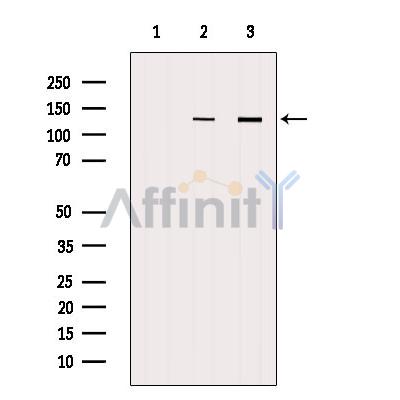产品描述
*The optimal dilutions should be determined by the end user.
*Tips:
WB: 适用于变性蛋白样本的免疫印迹检测. IHC: 适用于组织样本的石蜡(IHC-p)或冰冻(IHC-f)切片样本的免疫组化/荧光检测. IF/ICC: 适用于细胞样本的荧光检测. ELISA(peptide): 适用于抗原肽的ELISA检测.
引用格式: Affinity Biosciences Cat# DF6440, RRID:AB_2838403.
展开/折叠
ATP dependent helicase RENT1; ATP-dependent helicase RENT1; Delta helicase; FLJ43809; FLJ46894; HUPF 1; hUpf1; KIAA0221; Nonsense mRNA reducing factor 1; NORF 1; NORF1; pNORF 1; pNORF1; Regulator of nonsense transcripts 1; RENT 1; RENT1; RENT1_HUMAN; Smg 2; Smg 2 homolog nonsense mediated mRNA decay factor; UP Frameshift 1; Up frameshift mutation 1 homolog (S. cerevisiae); Up frameshift mutation 1 homolog; Up frameshift suppressor 1 homolog; Up-frameshift suppressor 1 homolog; UPF 1; UPF 1 regulator of nonsense transcripts homolog; upf1; UPF1 regulator of nonsense transcripts homolog; UPF1 RNA helicase and ATPase; Yeast Upf1p homolog;
抗原和靶标
- Q92900 RENT1_HUMAN:
- Protein BLAST With
- NCBI/
- ExPASy/
- Uniprot
MSVEAYGPSSQTLTFLDTEEAELLGADTQGSEFEFTDFTLPSQTQTPPGGPGGPGGGGAGGPGGAGAGAAAGQLDAQVGPEGILQNGAVDDSVAKTSQLLAELNFEEDEEDTYYTKDLPIHACSYCGIHDPACVVYCNTSKKWFCNGRGNTSGSHIVNHLVRAKCKEVTLHKDGPLGETVLECYNCGCRNVFLLGFIPAKADSVVVLLCRQPCASQSSLKDINWDSSQWQPLIQDRCFLSWLVKIPSEQEQLRARQITAQQINKLEELWKENPSATLEDLEKPGVDEEPQHVLLRYEDAYQYQNIFGPLVKLEADYDKKLKESQTQDNITVRWDLGLNKKRIAYFTLPKTDSGNEDLVIIWLRDMRLMQGDEICLRYKGDLAPLWKGIGHVIKVPDNYGDEIAIELRSSVGAPVEVTHNFQVDFVWKSTSFDRMQSALKTFAVDETSVSGYIYHKLLGHEVEDVIIKCQLPKRFTAQGLPDLNHSQVYAVKTVLQRPLSLIQGPPGTGKTVTSATIVYHLARQGNGPVLVCAPSNIAVDQLTEKIHQTGLKVVRLCAKSREAIDSPVSFLALHNQIRNMDSMPELQKLQQLKDETGELSSADEKRYRALKRTAERELLMNADVICCTCVGAGDPRLAKMQFRSILIDESTQATEPECMVPVVLGAKQLILVGDHCQLGPVVMCKKAAKAGLSQSLFERLVVLGIRPIRLQVQYRMHPALSAFPSNIFYEGSLQNGVTAADRVKKGFDFQWPQPDKPMFFYVTQGQEEIASSGTSYLNRTEAANVEKITTKLLKAGAKPDQIGIITPYEGQRSYLVQYMQFSGSLHTKLYQEVEIASVDAFQGREKDFIILSCVRANEHQGIGFLNDPRRLNVALTRARYGVIIVGNPKALSKQPLWNHLLNYYKEQKVLVEGPLNNLRESLMQFSKPRKLVNTINPGARFMTTAMYDAREAIIPGSVYDRSSQGRPSSMYFQTHDQIGMISAGPSHVAAMNIPIPFNLVMPPMPPPGYFGQANGPAAGRGTPKGKTGRGGRQKNRFGLPGPSQTNLPNSQASQDVASQPFSQGALTQGYISMSQPSQMSQPGLSQPELSQDSYLGDEFKSQIDVALSQDSTYQGERAYQHGGVTGLSQY
种属预测
score>80的预测可信度较高,可尝试用于WB检测。*预测模型主要基于免疫原序列比对,结果仅作参考,不作为质保凭据。
High(score>80) Medium(80>score>50) Low(score<50) No confidence
研究背景
RNA-dependent helicase and ATPase required for nonsense-mediated decay (NMD) of mRNAs containing premature stop codons. Is recruited to mRNAs upon translation termination and undergoes a cycle of phosphorylation and dephosphorylation; its phosphorylation appears to be a key step in NMD. Recruited by release factors to stalled ribosomes together with the SMG1C protein kinase complex to form the transient SURF (SMG1-UPF1-eRF1-eRF3) complex. In EJC-dependent NMD, the SURF complex associates with the exon junction complex (EJC) (located 50-55 or more nucleotides downstream from the termination codon) through UPF2 and allows the formation of an UPF1-UPF2-UPF3 surveillance complex which is believed to activate NMD. Phosphorylated UPF1 is recognized by EST1B/SMG5, SMG6 and SMG7 which are thought to provide a link to the mRNA degradation machinery involving exonucleolytic and endonucleolytic pathways, and to serve as adapters to protein phosphatase 2A (PP2A), thereby triggering UPF1 dephosphorylation and allowing the recycling of NMD factors. UPF1 can also activate NMD without UPF2 or UPF3, and in the absence of the NMD-enhancing downstream EJC indicative for alternative NMD pathways. Plays a role in replication-dependent histone mRNA degradation at the end of phase S; the function is independent of UPF2. For the recognition of premature termination codons (PTC) and initiation of NMD a competitive interaction between UPF1 and PABPC1 with the ribosome-bound release factors is proposed. The ATPase activity of UPF1 is required for disassembly of mRNPs undergoing NMD. Essential for embryonic viability. Together with UPF2 and dependent on TDRD6, mediates the degradation of mRNA hardoring long 3'UTR by inducing the NMD machinery (By similarity).
Phosphorylated by SMG1; required for formation of mRNA surveillance complexes.
Cytoplasm. Cytoplasm>P-body. Nucleus.
Note: Hyperphosphorylated form is targeted to the P-body, while unphosphorylated protein is distributed throughout the cytoplasm. Localized in the chromatoid bodies of round spermatids (By similarity).
Ubiquitous.
Found in a post-splicing messenger ribonucleoprotein (mRNP) complex. Associates with the exon junction complex (EJC). Associates with the SGM1C complex; is phosphorylated by the complex kinase component SGM1. Interacts with UPF2. Interacts with UPF3A and UPF3B. Interacts with EST1A. Interacts with SLBP. Interacts (when hyperphosphorylated) with PNRC2. Interacts with AGO1 and AGO2. Interacts with GSPT2. Interacts with isoform 1 and isoform 5 of ADAR/ADAR1. Interacts with SMG7. Interacts with ZC3H12A; this interaction occurs in a mRNA translationally active- and termination-dependent manner and is essential for ZC3H12A-mediated degradation of target mRNAs. Interacts with CPSF6. Interacts with MOV10; the interaction is direct and RNA-dependent. Interacts with SHFL; the interaction increases in the presence of RNA. Interacts with UPF2 and DDX4; interactions are mediated by TDRD6 (By similarity).
(Microbial infection) Interacts with human T-cell leukemia virus 1/HTLV-1 protein Tax; this interaction inhibits the host nonsense-mediated mRNA decay (NMD).
The [ST]-Q motif constitutes a recognition sequence for kinases from the PI3/PI4-kinase family.
Belongs to the DNA2/NAM7 helicase family.
研究领域
· Genetic Information Processing > Translation > RNA transport.
· Genetic Information Processing > Translation > mRNA surveillance pathway.
限制条款
产品的规格、报价、验证数据请以官网为准,官网链接:www.affbiotech.com | www.affbiotech.cn(简体中文)| www.affbiotech.jp(日本語)产品的数据信息为Affinity所有,未经授权不得收集Affinity官网数据或资料用于商业用途,对抄袭产品数据的行为我们将保留诉诸法律的权利。
产品相关数据会因产品批次、产品检测情况随时调整,如您已订购该产品,请以订购时随货说明书为准,否则请以官网内容为准,官网内容有改动时恕不另行通知。
Affinity保证所销售产品均经过严格质量检测。如您购买的商品在规定时间内出现问题需要售后时,请您在Affinity官方渠道提交售后申请。产品仅供科学研究使用。不用于诊断和治疗。
产品未经授权不得转售。
Affinity Biosciences将不会对在使用我们的产品时可能发生的专利侵权或其他侵权行为负责。Affinity Biosciences, Affinity Biosciences标志和所有其他商标所有权归Affinity Biosciences LTD.


